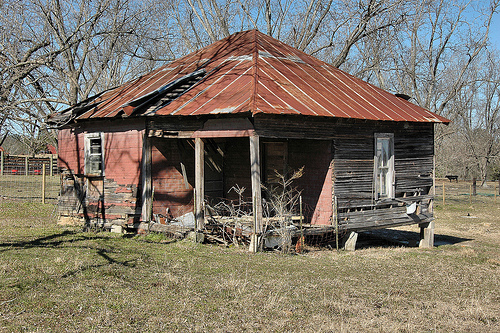Not Ugly, Thank You, Jesus
If not darkest, “gothic” Southern fiction of Flannery O’Connor (1925-1964) is surely strangest. A Southerner and therefore one of us, O’Connor knew us. With her eye on hypocrisy, she could have wrung a murky nightmare out of Paula and the N-Word in which evil to the innocent reader might have seemed Paula Deen, but obliquely would be the good churchgoing, Bible-believing, God-fearing Christians picking up stones as they circled Paula in self-righteous damnation.
O’Connor minced no punches and pulled no words, to turn it upside down. For our Seminary orientation week we had her The Complete Stories to read and discuss. The stories are horrifying, though the horror is not what people see, but what we neither see nor recognize that we are.
A favorite in one story was a used car salesman’s line, “Anyone with a good car don’t need salvation, and this is a good car.” Another is my image of a 1939 Buick sedan rolled, then uprighted and driven away. You could do that with a 1939 Buick.
With a ghastly hero, The Lame Shall Enter First has a scriptural allusion that we picked apart in class.
Strange as any, A Late Encounter With The Enemy is about the footsoldier from the War between the States whom somebody once called “General.” The rank stuck so that in a few years everybody including himself thought he had been a General of the Confederacy, and he loved going places in his dress uniform with sword. Though looking like a dried up spider, at 104 years old the General considered himself still handsome and attractive to the ladies, five feet four inches of pure game cock. His white hair reached to his shoulders and he would not wear teeth because he thought his profile was more striking without them. In full dress uniform, the General attends his granddaughter’s college graduation in a wheelchair, pushed by his nephew John Wesley in his boy scout uniform. John Wesley is a lazy child addicted to cokes. Toward the end of the graduation exercises the General dies sitting up ramrod straight in his wheelchair, eyes wide open. My favorite image in the story is the very end, about John Wesley. “That crafty scout had bumped him out the back way and rolled him at high speed down a flagstone path and was waiting now, with the corpse, in the long line at the Coca-Cola machine.”
O’Connor’s stories are macabre. One, “Revelation,” came specially to mind with the Paula Deen Fiasco. Assorted people are in a doctor’s small, crowded waiting room. Mrs. Turpin, who puts herself to sleep nights categorizing in her mind the classes of people Jesus has made and continually thanking Him for making her a nice, white, middle-class Christian woman with a good disposition and a little bit of everything, not a nxxxxr, not ugly, and not white trash like another woman in the room. “One thang I know,” the white-trash woman said. “Two thangs I ain’t going to do. Love no nxxxxrs or scoot down no hogs with no hose.”* (O’Connor, who pulls no words, does not substitue exes for eyes, gees and ees, as I have done here). Another in the doctor's waiting room is Mary Grace, an ugly, foul-tempered young woman who is a student at Wellesley way up in Massachusetts. Mary Grace takes a hatred for Mrs. Turpin, hurls a heavy book across the room, striking her in the face, and snarls at her, “Go back to hell where you came from, you old wart hog.” In horrified sorrow, Mrs. Turpin takes the girl’s curse as a condemning word from Jesus about what He thinks of her. “Revelation” is horrific but the poignant justice is oddly redemptive somehow even though nobody "gets it."
All this comes to mind as the Supreme Court decisions relating to same-sex marriage are read, probably because Flannery O’Connor would have gotten some darker than night stories out of this social struggle too. Notwithstanding Scalia, the court’s decisions seem right because although all government is all ways all bad, "better" government is not allowed to tell people what they can and cannot do.
For all sorts of reasons, abortion, a hot issue that divides even families, is but should not be stirred in with the same-sex marriage forum, because they are not related, except that politically both are emotionally set in concrete at the far ends of political spectrums. A long dead aunt whom I visited last week, once went into a vicious tirade at me when I said abortion should not be used for ordinary birth control. Retired from her long career as a civil servant with HEW, Washington, DC, my aunt raged that my view was racist and anti-feminine, and there should be no restrictions, but the business of the woman only. It was a non-discussion to which I listened open-mouthed. A quarter century on, I realize the intensity of feelings on all sides. Ever since, I have been less absolute in my certitudes, because someone I respect, even love, surely will disagree with me violently or at least strongly.
And, after all, I may be wrong.
A Catholic, Flannery O’Connor wrung horrifying stories out of Southern tarpaper shacks with the brick design stamped into the tarpaper.
I shudder to think what she would have done with abortion clinic murders and gay marriage lynchings by the righteous right.
TomW
* O’Connor, Flannery, “Revelation” in Flannery O’Connor The Complete Stories, page 494, FSG, NY, 16th printing, 1980. Winner of the 1971 National Book Award for fiction. (Extensive use of the word “nxxxxr” is hers, not mine).




